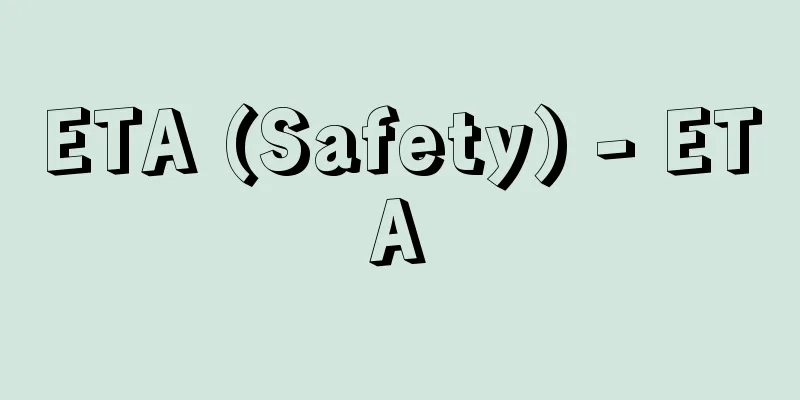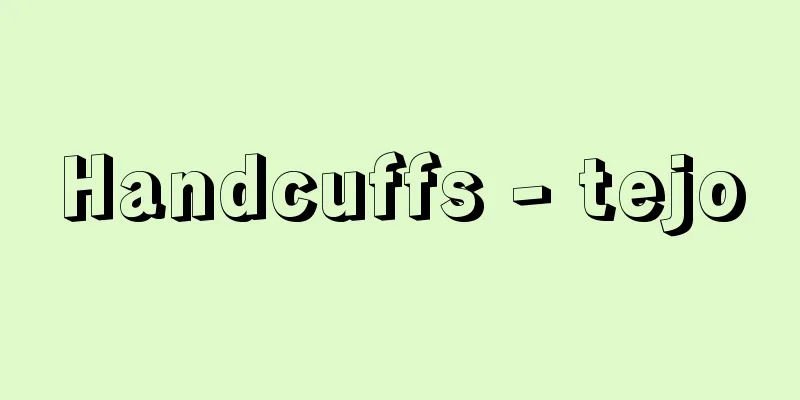Postage stamp - Yubinkitte (English spelling)

|
A certificate that is affixed to mail to prove that postage has been paid in advance and is issued by the government or an equivalent issuer, an institution commissioned by the government, or a company approved by the government. It is also simply called a stamp. [Amano Yasuji] The Birth of StampsThe world's first postage stamp was issued in England in 1840. At that time, postal reforms were being carried out in England by Rowland Hill (1795-1879), and as part of this, all postage was to be paid in advance, so stamps were issued as proof of this. The stamps issued at this time were 1 penny (black) and 2 pence (blue) stamps depicting Queen Victoria in profile. Beautifully printed intaglio, they were rectangular, measuring 19 mm wide x 22.4 mm long, and had glue on the back, but no perforations (holes made by a sewing machine to separate the stamps). The 1 penny stamp is nicknamed the Penny black, and the 2 pence stamp is nicknamed the Pence blue. The British prepayment system was a success, and stamps proved to be an extremely convenient way of proving prepayment of postage. As a result, it spread throughout the world, starting with Europe and the United States, and over the 180 years since then, more than 400,000 types of stamps have been issued by various countries. Hill also developed another method of prepayment of postage, envelopes and letter sheets (paper that can be folded and sent as a letter) with the postage amount printed on them, but this was not used much, and the method of affixing a stamp became the mainstream method of prepayment of postage. In Japan, four denominations of stamps were issued on April 20, 1871 (March 1, Year 4 of the Meiji Era, lunar calendar) when the government launched the postal system between Tokyo and Osaka. These stamps were printed on thin Japanese paper using the etching technique introduced from the Netherlands at the end of the Edo period, and had no backing or perforations, making them highly artistic but extremely inconvenient. The design of two dragons facing each other and framed around them was printed in a different color for each denomination, with the denomination number printed in black in the center, making them a two-color print, and they are known as dragon design stamps. [Amano Yasuji] Subsequent developmentsEarly postage stamps were issued only for the practical purpose of prepaying postage, so the designs were simple, such as coats of arms or portraits of heads of state. However, in the 20th century, around the time of World War II, there was a growing tendency to use stamps as a medium of propaganda, as they were affixed to mail and sent all over the world. Nazi Germany was the most active in this regard. They were beautifully printed with various themes to promote the policies and culture of the country, and stamps went from being mere prepaid certificates to being the "face" or "business card" of the country. After World War II, as printing technology improved and multi-color printing became commonplace, this trend spread further, especially in socialist countries. Meanwhile, developing countries and former socialist countries in Eastern Europe began to actively issue stamps with themes that would please collectors in order to earn foreign currency by selling stamps abroad. Furthermore, new media have been born one after another due to the development of communication technology, and the postal service is no longer the main media, which has made it difficult to manage the postal service in industrialized countries. In addition, postage meters are being used within the postal service, the number of mail items that are postage-paid or postage-paid has increased, and the affixing of postage has become unnecessary, so that stamps are losing their main role in the postal service. As a result, even in industrialized countries, they have started to focus on the marketability of stamps themselves and have adopted active issuance policies aimed at collectors. For this reason, in addition to their original character as prepaid certificates, stamps are increasingly becoming small, beautiful works of printed art that depict all sorts of subjects. Furthermore, as a global trend, many countries have begun to issue a variety of stamps in small quantities in order to increase revenue, and many unusual stamps, such as sticker-type stamps that can be affixed to envelopes without moistening the backing, have appeared, and with the arrival of the 21st century, stamps have entered an era of prolific issuance. In short, it can be said that stamps have changed in character from "national business cards" to convenient, beautiful labels. Japan is no exception to this trend. [Amano Yasuji] Stamp typesRegular stampsStamps that are always available at post offices and are always available for sale are called ordinary stamps. There are many different types with different price ranges to accommodate postal rates. The designs are usually standardized on one theme and are used for at least a few years before being replaced with a design of a different theme. In Japan, there are (1) hand-carved stamps (1871-1876), (2) oval stamps (1876-1892), (3) chrysanthemum stamps (1899-1907), (4) old high-value stamps (1908-1914), (5) Tazawa stamps (1913-1937), (6) Fujishika stamps (1922-1937), (7) earthquake stamps (1923), (8) new high-value stamps (1924-1937), (9) landscape stamps (1937), (10) and (11). (1) Showa stamps (1937-1946), (11) New Showa stamps (1946-1948), (12) Industrial design stamps (1948-1950), (13) Showa no watermark stamps (1951-1952), (14) National Treasure Flora and Fauna Design Stamps (1950-1965), (15) New National Treasure Flora and Fauna Design Stamps (1966-1989), (16) Heisei stamps (1992-2019). [Amano Yasuji] Commemorative and promotional stampsA stamp issued temporarily to advertise important events, focusing on the fact that it is affixed to mail and is seen by many people in addition to its original function of prepaying postage. The first stamp in the world was a stamp commemorating the 20th anniversary of Peru's railway in 1871. The first stamp in Japan was a stamp commemorating the silver wedding anniversary of Emperor Meiji in 1894 (Meiji 27), the fourth in the world. In the 20th century, many beautiful commemorative stamps were issued, and they were not only issued to commemorate events in the narrow sense, but also to promote national policies and culture in a broad sense, and series depicting animals and plants, art, vehicles, sports, etc. for collectors were actively issued. Japan is no exception to this. In Japan, there are also series depicting national and quasi-national parks, and stamps issued for New Year's mail. [Amano Yasuji] Airline stampsThe first airmail stamps were issued in Italy in 1917. In Japan, the first was issued to commemorate an airmail test flight between Tokyo and Osaka in 1919 (Taisho 8). Many foreign airmail stamps are special stamps that can only be used for airmail, but Japanese airmail stamps are ordinary stamps with a face value equivalent to the airmail postage fee. Airmail stamps were issued specially because in the early days of airmail, aircraft were small and could only carry a small amount of mail at a time, making the postage relatively expensive. However, as aircraft began to account for a large proportion of mail transportation, the postage fees became cheaper and airmail no longer needed to be treated as something special. As a result, the issuance of airmail stamps is on the decline worldwide. [Amano Yasuji] Additional fee stampsA stamp sold for an amount that can be used for postage plus an additional amount to be used for donations. The stamps are widely sold and used by many people, and are issued for the purpose of collecting donations for social welfare and relief projects, cultural projects, sports events, etc. The world's first stamps with additional money were issued in 1897 by New South Wales and Victoria (both now states of Australia). In Japan, three types of patriotic stamps (2-sen, 3-sen, and 4-sen stamps with an additional money of 2-sen each) were issued in 1937 (Showa 12) to raise funds for the construction of an airport for civil aviation. [Amano Yasuji] Military stampsIn peacetime, some countries offer free postage for letters sent by military personnel from the military, with conditions such as reduced postage or restrictions on the number of letters sent. These types of postal stamps are called military stamps, and were first issued in France in 1901. In Japan, they were first issued in 1910 (Meiji 43) after the Russo-Japanese War, and were issued to non-commissioned officers and soldiers stationed in Manchuria and the Korean Peninsula until around 1942 (Showa 17). During the war, the military postal system was free in principle for soldiers deployed to the battlefields. [Amano Yasuji] Regional stampsRegional stamps are stamps used only in specific regions or specific postal routes within a country, and were used in Japan in Tosa Province (Kochi Prefecture) for several years from 1872 (Meiji 5). They were used in the special postal system "mura-sukuri" from the old feudal era. They were also issued in Taiwan, which had been cut off from mainland Japan immediately after Japan's defeat in World War II in 1945 (Showa 20), just before it was taken over by the Republic of China. [Amano Yasuji] Hometown stampsHometown stamps are stamps that are issued in a specific region of a country but are valid anywhere in the country. In Japan, they have been issued by local post offices (currently Japan Post Co., Ltd. post offices) since 1989, and the types of stamps issued have been increasing every year. Among them are ordinary stamps, promotional stamps, and commemorative stamps. Although these stamps were later issued in a different format so that they can be issued nationwide, even though they are still stamps advertising a specific region, they are still called hometown stamps. [Amano Yasuji] othersOther stamps that do not exist in Japan include registered postage stamps exclusively for registered mail, express postage stamps exclusively for express mail, parcel postage stamps exclusively for parcel mail, deficiency postage stamps to collect deficiency fees, and official postage stamps exclusively for official mail. [Amano Yasuji] Stamp productionPrinting and manufacturing factorySince its establishment, stamps in Japan have been issued by the government agency in charge of the postal service, but since April 2003, it has been issued by Japan Post, and since October 2007, when the postal service was privatized, it has been issued by Japan Post Co., Ltd. (since 2012, Japan Post). In the past, most of the printing and production of stamps was done by the Printing Bureau of the Ministry of Finance. This Printing Bureau became the National Printing Bureau, an independent administrative institution, in April 2003. Even now, most of the ordinary stamps are produced here, but as a result of the introduction of a bidding system for ordering commemorative stamps and hometown stamps to reduce costs, many of them are produced by private companies such as Cartor Security in France and Toppan Printing Co., Ltd. More and more countries abroad are adopting the bidding system, and with the trend towards small-scale production of a wide variety of stamps, the number of small companies has increased and competition is on the rise. [Amano Yasuji] Original version and practical version, manufacturing and sales unitsSince the first stamp, most postage stamps have been printed on small rectangular pieces of paper. Because they are small, they are usually printed in a practical version of several hundred pieces arranged vertically and horizontally at regular intervals. To do this, plates are made by various methods from an original plate (in the case of gravure printing, an original dry plate) carved based on the original design, and then these plates are joined together to make a large practical version. These are printed on paper that has already been glued, punched or rolled for separation, and cut to an appropriate size for easy sale at the post office counter to become a counter sheet, which contains 10 to 100 stamps, or sometimes more. From this, they are separated and sold as needed, but there are also sheets with stamps that are connected in an irregular way, such as a continuous print in which two or more stamps with different designs are printed on one sheet, or the Tate-Besch print, in which adjacent stamps are the same but printed in opposite directions. Stamps sold by post offices include sheets connected vertically and horizontally, small sheets made of several stamps, or sometimes different stamps combined and printed on a small piece of paper for easy storage, coil stamps, which are several hundred to a thousand stamps connected in a row, and stamp booklets, which are small units called panes, each of which is made up of several stamps bound together and has a cover. Coil stamps are often sold from vending machines. In recent years, more and more countries are adopting self-adhesive stickers instead of the usual moistened glue, and Japan is no exception. [Amano Yasuji] Printing methodThere are four basic types of stamp printing formats: (1) Letterpress printing: Ink is applied to the raised areas of the plate to print. This is the oldest printing method since Gutenberg, and was once widely used, but is rarely seen these days. The first stamps issued by the Swiss canton of Basel and the Dutch East Indies (now Indonesia) in 1845 were the first examples of this method. In Japan, the first oval stamps were issued in 1876 (Meiji 9) under the direction of Italian E. Chiossone, and until around 1950, most regular stamps were printed using this method, but its use has since decreased and fallen out of use. (2) Intaglio printing Ink is applied to the recessed parts of the plate and printed. The finished stamp appears to have raised ink. Although printing costs are high, it is difficult to forge and, above all, the finished product is beautiful, so it is still used today. It has been used since the world's first stamp was issued by Britain in 1840. In Japan, hand-engraved stamps, from the first dragon stamp to the cherry blossom stamp, were made using etched copperplate, a primitive form of intaglio printing, and the first modern intaglio printing was the victory stamps (4 types) issued in 1896 to commemorate the Sino-Japanese War. (3) Gravure printing: A type of intaglio printing in a broad sense, also known as photo-intaglio printing. Indentations in the plate to hold the ink are made using photography and chemicals, or photography and a diamond needle connected to a phototube or computer. Gravure printing is suitable for printing primary colors, as it is easy to produce intermediate tones. For this reason, it is a printing method representative of the modern era, when multicolored stamps are the norm. The world's first example was issued in 1914 by the Duchy of Bavaria (now a state in the Federal Republic of Germany). In Japan, the first stamps were issued in 1936 (Showa 11), for the Fuji-Hakone National Park stamps (four types), and it has since become the mainstream for printing commemorative stamps. (4) Lithographic printing Taking advantage of the fact that water and oil repel each other, oil-based ink is applied to the smooth surface of the plate, and other parts are constantly moistened before printing. Initially, this was done using a lithograph, but the offset printing method, in which the ink is first transferred to a rubber roller, was invented and became widely used. The first stamp issued in the Swiss canton of Zurich in 1843 is the oldest example of lithographic printing. In Japan, the oldest example is the four stamps issued in 1921 (Taisho 10) commemorative stamps for the Crown Prince's return to Japan, which were offset-printed. The earthquake stamps issued in a hurry after the Great Kanto Earthquake, and some of the Showa and Shin Showa stamps issued around the time of Japan's defeat in World War II were also offset-printed. Until this time, lithographic printing was not used much except for rush printing, as it was easy to make counterfeits. However, because it is suitable for printing primary colors, it has been used frequently in recent years for printing multi-color stamps. Recently, in addition to regular printing, stamps with gold foil or holograms, as well as stamps printed on materials other than paper, have also appeared. [Amano Yasuji] Stamp classification and collectingCollection by countryThe traditional method of classifying stamps is to classify stamps by issuing country and then sort them in order of issue, or to group stamps by type within each country and arrange them in order of issue. Specifically, stamps are first classified according to the various characteristics of each stamp, such as face value, design, and sometimes printing color and paper quality. These are then arranged in order by country and given numbers to form main numbers, which are the basic types of stamps. In some cases, the main numbers are further classified by taking into account small differences in printing color, paper, and print surface, as well as differences in perforation and backing paste, to form sub-numbers, and the collector's preference is how detailed the classification is. Stamps classified in this way are listed in numerical order in a catalog, which is usually organized by country, but there are also world stamp catalogs that cover stamps from all over the world. Examples include the American "Scott", the French "Ibert", the British "Gibbons", and the German "Michel". However, collecting stamps from all over the world is now virtually impossible, and many collectors choose to collect stamps from specific countries. Furthermore, some enthusiastic collectors specialize in collecting stamps from specific types of stamps within a country, particularly specific series of ordinary stamps, by classifying them in detail. In such cases, the general trend is to classify and collect stamps not only from the perspective of their production, but also from the perspective of how they were used after being affixed to mail. In other words, from the postmark and date stamps affixed to the stamps to prevent reuse and to indicate the name of the handling office and the date, it is possible to know which post office used them and when. If the stamp is still attached to the envelope (as it was when it was delivered as mail), it is also possible to know what type of mail it was used for and how much it cost. In this way, the ultimate form of collecting stamps by country is to classify and organize stamps according to all conditions, and to systematically collect them so that the overall picture of the stamp can be understood from both the perspective of production and use. Catalogues that serve as guidelines for collecting stamps are published for each country. In the case of Japanese stamps, there are the "Sakura Japanese Stamp Catalogue" (Japanese Philatelic Association) and the "Japan Stamp Catalogue" (Japan Post Stamp Dealers Association), which focus on main numbers, as well as the "Japanese Stamp Specialist Catalogue" (Japan Philatelic Publishing), which is a specialized catalog. The first two are published annually. [Amano Yasuji] Postal History CollectionThis type of collecting has become popular in recent years, aiming to elucidate the development and evolution of postal services using used stamps and especially entires (envelopes and postcards in the state they were delivered as mail). Since you must find a theme, create a plan, and assemble your collection yourself, it is an intellectual collecting style that requires deep knowledge of postal services and the ability to organize. Taking Japanese postal services as an example, the period covered is often one rich in interesting topics and materials, such as postal services at the time of their founding, mail services during emergencies such as disasters and wars, such as the Great Kanto Earthquake and World War II, and the chaotic periods before and after the defeat, military mail services for soldiers in battlefields, and mail services in former colonies. [Amano Yasuji] Collection by design and themeAs stamp designs began to depict all sorts of things, the practice of classifying and collecting stamps by the subject matter, regardless of nationality, became popular especially after the Second World War. The main subjects are animals, plants, vehicles, music, art, and sports, but these are often further subdivided and collected. In the case of vehicles, they are divided into railways, ships, automobiles, airplanes, and horse-drawn carriages, and railways are further subdivided into steam locomotives and electric trains. Going one step further from this trend, collecting by theme has become popular. It is not just about collecting the same subject matter depicted in the design, but also about collecting a wide range of items such as entires with the stamps affixed and commemorative postmarks with the same subject matter, and assembling various materials centered around the stamps to develop a story around a single theme. This collecting method is characterized by the strong individual creativity in setting the theme, selecting the materials, and assembling them. [Amano Yasuji] Collection BasicsThe basis of stamp collecting is the collection of single stamps that are separated one by one. Several to a dozen stamps are arranged and pasted on album pages of a certain size, and an explanation is written so that the viewer can understand. The stamps pasted on one page are related to each other in terms of classification and organization, and such pages are gathered into dozens or hundreds of pages to create a collection by country or theme. It is a research, a story made up of stamps. In this way, stamp collecting has a unique and complex interest that goes one step further than appreciating each piece of collection. In addition to the complexity of classification, this kind of systematic collection is a characteristic of stamp collecting, which is why it is called philately, and collectors and researchers are called philatelists. Therefore, collecting newly issued commemorative stamps by simply storing them as sheets or by putting them in a stock book (a book with several pockets on each page in which stamps are stored) is just "stamp collecting" and cannot be called "stamp collecting". [Amano Yasuji] Collecting toolsStamp collecting requires several tools. First, to handle stamps, a pair of tweezers with flat tips is used. This is to prevent the stamps from getting dirty from sweat or oil from the fingertips. As mentioned above, stamps are organized in albums for storage. There are illustrated albums, which are framed so that stamps with main numbers can be pasted in order by country, with photos of the stamps and stamp pasting positions clearly indicated, and blank albums, which allow the collector to arrange and paste stamps as they like. The former is mainly used by beginners in collecting by country, while the latter is used by those who collect by design or theme, or those who have reached the professional level of collecting by country. To paste stamps into an album, a small piece of glassine paper with glue on the back, called a hinge, is usually used. When using this, it often leaves marks on the glue on the back of unused stamps. For this reason, in recent years, mounts, which are made by stacking two sheets of acetate film and gluing the bottom part of the lower one, with glue on the back of the lower one, are sometimes used. These are cut to a size slightly larger than a stamp, moistened with glue on the back, and pasted into an album. Stock books are used to temporarily store stamps before pasting them into an album. It is not advisable to store stamps in a stock book for a long time, as it is difficult to organize them and there is a risk of damaging them if they are moved around. [Amano Yasuji] Stamp ConditionThe most important thing in stamp collecting is to maintain the condition of the stamps. Ideally, unused stamps should be in the same condition as when they were sold by the post office. Specifically, they should be fresh and not sun damaged, with the glue on the backing still intact. It is better if there are no hinge marks, especially those from after World War II. However, it is natural that there will be some on old stamps. Used stamps naturally have no glue on their backing, but it is better if the stamp has a clear postmark and the post office name and year are legible. When collecting by design or theme, the postmark will get in the way of the design, so try to collect as many unused stamps as possible. When showing examples of use by country or collecting postal history, it is desirable for the postmark to be clear and for the stamp's imprint to cover as much of the stamp as possible. In addition, unused and used stamps with equal margins between the stamp face and the perforation are called well-centered, and it is best to collect stamps as close to this condition as possible. Stamps with defects such as sun damage, tears, rips, peeling paper (especially the surface), dirt, and creases will drop in value significantly, and new stamps will be almost worthless. To maintain the condition of stamps, it is important to pay attention to preservation, with moisture, ultraviolet rays, and dust being the biggest enemies. Always use albums with outer boxes, and store them upright in a dark, low-humidity place. [Amano Yasuji] Obtaining stampsNewly issued Japanese stamps and current ordinary stamps are available at post office counters. Newly issued stamps are also available by mail order, and stamps dating back to the past are also sold. New foreign stamps can be ordered directly from philatelic agencies in each country that provide services to collectors. However, for old stamps, although collectors can exchange them with each other, the quickest way is to buy them from a dealer that specializes in selling stamps, and in the case of foreign stamps, new stamps are also handled. Auctions are also popular, and several dealers hold them regularly every month in Tokyo and Osaka. For used stamps, social welfare organizations can purchase stamps with paper (stamps used for postage that have been cut out from the envelope leaving a small margin) in bulk, and then water-peeling them off, or old letters can be shared with old families. [Amano Yasuji] Collection ActivitiesIn order to improve their collections, stamp collectors gather together to conduct research and exchange information and stamps, and also hold activities such as stamp exhibitions, publishing journals, stamp classes to teach stamp collecting, and lectures to promote the hobby of collecting. There are collectors' groups that are organized by region or by people who collect in the same field, but the largest collectors' group with a nationwide membership in Japan is the Japan Philatelic Society (JPS), a public interest incorporated foundation headquartered in Tokyo. As of 2019, the number of members was approximately 6,600, and it publishes the journal "Philatelic." In addition to the aforementioned catalogs, they also publish introductory books and specialized books in each field. [Amano Yasuji] Popular stampsThe most expensive stamp (single stamp) in the world is a printing error on the Swedish No. 1 3 shilling bank stamp issued in 1855. The stamp is printed in yellow, not blue-green, as the 8 shilling bank stamp should be. Only one copy of this stamp is known to have been used, and it sold for 2,875,000 Swiss francs (US$255 million) at auction in Switzerland in 1996, beating the previous record of $935,000 (US$240 million) held by a 1856 1-cent stamp from British Guiana (now Guyana) at auction in 1980. The most expensive entire in the world is an envelope containing a single 5-cent (blue) stamp issued by the Director of the Alexandria Bureau in 1846, before postage stamps were officially issued in the United States. In 1981, it was sold for $1 million (equivalent to 215 million yen at the time) at a David Feldman auction in Geneva. The most expensive stamps in Japan are "20 sen cherry stamps with kana (a)" issued in 1874 (Meiji 7) and "6 sen cherry stamps with kana (a)" issued in 1875. Both are 3 or 4 existing copies. Another type is a reprint of the face value numeral "500 mon" in the center of the first stamp, "Ryu 500 mon", and "Ryu 500 mon" (500 mon)" (1 piece that has been used) has been discovered. Both are rated 30 million yen in catalogs, but the "Ryu 500 mon) face value numerals reprinted for 21 million yen at an auction held in Tokyo in 1973 (Showa 48). There are no records of the other two types of stamps being sold at a public auction. [Amano Yasuji] "Amano Yasuji, "Japanese Stamps and How to Collect They" (1977, Japan Philharmonic Publishing)" ▽ "Uoki Imai Osamu, "How to Collect Foreign Stamps" (1978, Japan Philharmonic Publishing)" ▽ "Imai Osamu, "Introduction to Collecting Stamps and Enjoying Stamps" (1980, Shogakukan)" ▽ "Amano Yasuji, "How to Collect Japanese Stamps" (1980, Japan Philharmonic Publishing)" ▽ "Uoki Imao, "The Correct How to Collect Stamps" (1981, Japan Philharmonic Publishing)" ▽ "Uoki Shun, "How to Double the Fun of Stamps" (1982, Japan Philharmonic Association)" ▽ "Otani Hiroshi, "Stamps Talk" (1985, Uo Publishing)" ▽ "Uomura Shun, "Cultural Journal of Stamps" (1996, Gakuyo Shobo)" [Reference Items] | | | | | | | | | | |Horography | |Postal Mail | | [Complete Materials] |Source: Shogakukan Encyclopedia Nipponica About Encyclopedia Nipponica Information | Legend |
|
郵便物に貼付(ちょうふ)して、郵便料金を前納したことを証するため、国またはそれに準ずる発行体、国の委託を受けた機関、国から認可を受けた企業などが発行する証票。単に切手ともいう。 [天野安治] 切手の誕生世界最初の郵便切手は1840年イギリスで発行された。当時のイギリスではローランド・ヒルRowland Hill(1795―1879)による郵便改革が行われており、その一環として郵便料金はすべて前納されることになったため、それを証明するための証票として切手が発行されたのである。このとき発行されたのは、ビクトリア女王の横顔を描く1ペニー(黒色)と2ペンス(青色)の切手。美しい凹版印刷で、横19ミリメートル×縦22.4ミリメートルの矩形(くけい)、裏糊(のり)はつけられていたが、目打(めうち)(切手を切り離すためのミシンの穴)は入れられていなかった。1ペニーの切手はペニー・ブラックPenny black、2ペンスの切手はペンス・ブルーPence blueの愛称でよばれている。 イギリスの料金前納制は成功し、切手は郵便料金前納を証明する方法としてきわめて便利であることがわかった。その結果、欧米諸国をはじめとして全世界に広がり、以来今日までの180余年間に40万種を超す切手が各国から発行されている。ヒルは郵便料金前納のもう一つの方法として、料額印面をあらかじめ刷り込んだ封筒とレター・シート(折り畳んで、そのまま手紙として差し出せる便箋(びんせん))も用意したが、あまり使用されず、切手貼付の方法が郵便料金前納方法の主流となっていった。 日本では、1871年4月20日(明治4年3月1日=旧暦)政府による東京―大阪間の郵便制度の発足とともに、48文(もん)、100文、200文、500文の4種類の切手が発行された。これは、幕末にオランダから渡来したエッチングの技術を用いて薄手和紙に印刷されており、裏糊も目打もなく、芸術性豊かではあったが、不便きわまりなかった。2匹の竜が向かい合ったものに、周囲に枠をつけた図案部分は、額面ごとに異なった色で印刷されており、その中央に黒色の額面数字が印刷された2色刷りで、竜文(りゅうもん)切手とよばれている。 [天野安治] その後の発展初期の郵便切手は郵便料金前納という実用的な目的だけで発行されていたため、図案も紋章や元首の肖像など、じみなものであった。しかし、20世紀に入り、第二次世界大戦前ごろから、切手が郵便物に貼られて全世界に送られることに注目して、これを宣伝媒体として利用する傾向が強くなってきた。これにもっとも積極的であったのがナチス・ドイツであった。さまざまな題材を美しい印刷で表現し、その国の政策や文化の宣伝を行うもので、切手は単なる料金前納の証票から、その国の「顔」あるいは「名刺」といった性格をもつようになってきた。第二次世界大戦後、印刷技術が向上し、多色刷りがあたりまえになってくると、社会主義国を中心に、この傾向はさらに拡大されていく。一方、開発途上国やかつての東欧社会主義諸国では、外国に切手を売って外貨を稼ぐため、収集家の喜ぶような題材の切手も盛んに発行されるようになった。 さらに、通信技術の発達から次々とニューメディアが生まれ、郵便事業はメディアの主役ではなくなってきたこともあって、先進工業諸国では郵便事業の経営がむずかしくなってきた。加えて、郵便事業のなかでも、料金計器が使われたり、料金別納・後納の郵便物が増加し、切手貼付を省略することが多くなってきて、切手は郵便事業の主役の座を失ってきている。その結果、先進工業国でも、むしろ切手自体の市場性に着目して、収集家を目当てとした積極的な発行政策がとられるようになった。このため、切手は料金前納の証票という本来の性格に加えて、あらゆるものを題材とした、小さくて美しい印刷芸術品といった性格を強めつつある現状である。 さらに世界的傾向として、収入増大を図るため、多くの国で多種類の切手を少量ずつ発行するようになり、裏糊を湿らせなくても封筒に貼れるシール式の切手など、変わった形態のものも数多くみられ、21世紀を迎えて、切手は乱発時代に入ってきた。ひとことでいえば、切手は「国の名刺」からお手軽な美しいラベルへとその性格を変えてきたといえよう。これは日本も例外ではない。 [天野安治] 切手の種類普通切手郵便局に常備され、いつでも売られている切手を普通切手という。郵便料金に適応するように料額の異なった多くの種類がそろえてある。図案は一つのテーマで統一され、少なくとも数年間は使用されたのち別のテーマの図案にかえられるのが普通である。日本では、(1)手彫(てぼり)切手(1871~1876)、(2)小判切手(1876~1892)、(3)菊切手(1899~1907)、(4)旧高額切手(1908~1914)、(5)田沢(たざわ)切手(1913~1937)、(6)富士鹿(ふじしか)切手(1922~1937)、(7)震災切手(1923)、(8)新高額切手(1924~1937)、(9)風景切手(1926~1937)、(10)昭和切手(1937~1946)、(11)新昭和切手(1946~1948)、(12)産業図案切手(1948~1950)、(13)昭和すかしなし切手(1951~1952)、(14)動植物国宝図案切手(1950~1965)、(15)新動植物国宝図案切手(1966~1989)、(16)平成切手(1992~2019)というように発行されている。 [天野安治] 記念切手・宣伝切手郵便料金前納という本来の役目以外に、郵便物に貼られて多くの人の目に触れるという点に着目して、重要な行事などについて宣伝するために一時的に発行される切手。1871年ペルーの鉄道20周年記念切手が世界最初。日本最初のそれは1894年(明治27)の明治天皇銀婚式記念切手(2銭、5銭の2種類)で、世界で4番目。20世紀に入ると、記念切手は美しいものが数多く発行されるようになって、狭い意味の行事を記念するだけでなく、国の政策や文化などを幅広く宣伝する宣伝切手や、収集家を意識した、動植物、美術品、乗り物、スポーツなどを描くシリーズものなどが盛んに発行されるようになってきた。これは日本でも例外ではない。日本ではほかに国立公園・国定公園などを描くシリーズ、年賀郵便用に発行される切手などもある。 [天野安治] 航空切手1917年にイタリアで発行されたのが最初。日本では1919年(大正8)に行われた東京―大阪間の航空郵便試験飛行を記念して発行されたのが最初である。外国の航空切手は航空郵便にのみ使える専用切手が多いが、日本のそれは航空郵便料金相当額面の普通切手という性格のものである。航空切手が特別に発行されたのは、初期の航空郵便では、航空機が小さく、一度に少量の郵便物しか積めなかったため、料金が割高だったからである。しかし、郵便物の運送の多くの部分を航空機が占めるようになると、料金は安くなり、航空郵便を特別視する必要はなくなってきた。そのため、世界的に航空切手の発行は減少の傾向にある。 [天野安治] 付加金付き切手郵便料金に使用できる金額に、寄付金に使われる金額を上乗せした金額で売られる切手。切手が広く多くの人に売られ、使用されることを利用して、社会福祉・救済事業や文化事業、スポーツ・イベントなどに使用する寄付金を集める目的で発行される。世界最初の付加金付き切手は1897年ニュー・サウス・ウェールズとビクトリア(いずれも現、オーストラリアの1州)のもの。日本のそれは民間航空用の飛行場建設資金募集のため、1937年(昭和12)発行された愛国切手3種類(2銭、3銭、4銭へそれぞれ付加金2銭付き)。 [天野安治] 軍事切手平時において軍人が軍隊から出す手紙は、郵便料金を安くしたり、通数の制限などの条件をつけて無料にした国がある。このような種類の郵便物専用切手を軍事切手といい、最初は1901年フランスで発行された。日本でも日露戦争後の1910年(明治43)に初めて発行され、1942年(昭和17)ごろまで満州や朝鮮半島に駐屯する下士官、兵士へ支給し使用された。なお、戦争中は、戦地に派遣された軍人には原則として無料の軍事郵便制度が適用された。 [天野安治] 地方切手地方切手は、一国のなかの特定地域、特定郵便ルートなどに限って使われた切手で、日本でも1872年(明治5)から数年間、土佐国(高知県)で使用された。旧藩政時代からの特別の郵便制度「村送り」で使われたもの。1945年(昭和20)第二次世界大戦敗戦直後、日本本土との交通が途絶していた台湾でも中華民国に接収される直前に発行された。 [天野安治] ふるさと切手発売されるのは一国のなかの特定の地域であるが、全国どこでも通用する切手が、ふるさと切手である。日本でも、1989年(平成1)から地方郵政局(現、日本郵便株式会社郵便局)単位で発行されるようになり、年々、発行の種類が増えている。そのなかには、普通切手あるいは宣伝切手といったものと、記念切手としての性格をもつものとがある。これらの切手は、その後、特定地域の宣伝をする切手でありながら、全国発売されるように発行形態が変わってきたが、やはりふるさと切手とよんでいる。 [天野安治] その他このほか、日本にないものとして、書留郵便専用の書留切手、速達郵便専用の速達切手、小包郵便専用の小包切手、不足料金を徴収するための不足料切手、公用郵便物専用の公用切手などがある。 [天野安治] 切手の製造印刷・製造工場日本の切手は、創業以来、郵便事業を所管する官庁が発行してきたが、2003年(平成15)4月から日本郵政公社が、さらに郵便事業が民営化された2007年10月より郵便事業株式会社(2012年より日本郵便)が発行している。かつて、その印刷・製造はほとんどが大蔵省印刷局で行われてきた。この印刷局は2003年4月から独立行政法人国立印刷局となった。現在でも普通切手の大部分はここで製造されているが、記念切手、ふるさと切手などはコスト削減のためその発注に入札制度が導入された結果、フランスのカルトールCartor Security社、凸版印刷株式会社など民間会社製造のものが多くなってきている。外国でも入札制度を採用する国が増加、これに多種類少量生産の傾向も加わって、小規模企業の乱立、競争の様相を呈してきている。 [天野安治] 原版と実用版、製造と販売の単位郵便切手は最初の切手以来、ほとんどが四角形の小型の紙片に印刷されている。小型のため普通は数百枚を縦横に一定の間隔を置いて並べた実用版で印刷する。そのためには原図をもとに彫刻された原版(グラビア印刷の場合は原乾版)から、いろいろな方法を用いて版を増やし、それを大きくつなげて実用版をつくる。これをあらかじめ糊引きしてある用紙に印刷し、切り離すための目打やルレットを入れ、郵便局の窓口で売りやすいように適当な大きさに切断したものが窓口シートで、10枚から100枚、場合によってはそれ以上の枚数の切手がつながった状態になっている。これから必要に応じて切り離して販売されるが、一つのシートのなかに、2種以上の異なった図案の切手がつながった形で印刷された、連刷とよばれる形のもの、同じ切手ではあるが、隣どうしの切手が逆の方向に向けて印刷されているテート・ベッシュなど、切手が変則的なつながり方になっているシートもある。郵便局から売られる切手の単位は、縦横につながったシートのほかに、数枚の切手、場合によっては種類の違う切手を組み合わせて小さな紙片に印刷し、保存に便利なようにした小型シート、1列に数百枚から1000枚つながったコイル切手coil stamps、数枚の切手がつながったペーンpaneとよばれる小さな単位を綴(と)じ、表紙をつけている切手帳bookletなどがある。コイル切手は自動販売機で売られる場合が多い。また、近年、裏糊も湿らせて貼り付ける普通の糊にかわって、シール式のセルフ糊を採用する国が増加しているが、日本も例外ではない。 [天野安治] 印刷方式切手を印刷するときの版式には基本的に次の4種類がある。 (1)凸版印刷 版面の高く盛り上がったところにインキをつけて印刷する。グーテンベルク以来のもっとも古い版式で、かつては多用されたが、最近はほとんどみかけなくなった。1845年スイスのバーゼル州とオランダ領東インド(現、インドネシア)発行の各最初の切手が、この版式の最初の例。日本では1876年(明治9)イタリア人E・キヨソーネの指導で発行された小判切手が最初で、1950年ごろまでは、普通切手のほとんどはこの版式で印刷されていたが、その後減少、使用されなくなった。 (2)凹版印刷 版面のへこんだ部分にインキをつけて印刷する。できあがった切手はインキが盛り上がったようにみえる。印刷コストは高くつくが、偽物がつくりにくく、なにより仕上がりが美しいので、いまでも使用されている。1840年発行のイギリスの世界最初の切手から使用された。日本では最初の竜文切手から桜切手までの手彫切手はエッチング銅版で、原始的ながら一種の凹版印刷であるが、近代的なその最初は1896年の日清(にっしん)戦争勝利記念切手(4種類)であった。 (3)グラビア印刷 広い意味で凹版の一種で、写真凹版ともよばれる。インキをつける版のへこみを写真と薬品でつくるか、写真と光電管、コンピュータに結び付けられたダイヤモンド針でつくるもので、中間のトーンが出しやすく、原色の印刷に向いている。そのため、切手の多色化が一般的となっている現代を代表する印刷方式となっている。1914年バイエルン公国(現、ドイツ連邦共和国の1州)で発行されたのが世界最初の例。日本では1936年(昭和11)発行の富士箱根国立公園切手(4種類)が最初で、その後、記念切手印刷の主流となった。 (4)平版印刷 水と油は互いにはじくという性質を利用して、凹凸のない版面に油性のインキをつけ、ほかの部分には絶えず水気を与えておいて印刷する。最初は石版の形で行われていたが、ゴムのローラーにいったん転写するオフセット印刷方式が発明され、広く使用されるようになった。1843年スイスのチューリヒ州で発行された最初の切手が平版印刷による最古の例。日本では1921年(大正10)発行の皇太子帰朝記念切手(4種類)がもっとも古い例であるが、これはオフセット方式。関東大震災後、まにあわせに発行された震災切手、第二次世界大戦敗戦前後に発行された昭和切手・新昭和切手の一部もオフセット方式で、このころまでは、平版印刷は偽物がつくられやすいということもあって、まにあわせに発行される場合以外には、あまり使われなかった。しかし、原色の印刷に向いているため、最近では多色刷り切手の印刷に多用されている。また最近では、通常の印刷のほかに、金箔(きんぱく)やホログラムを施した切手、紙以外のものに印刷された切手も出現している。 [天野安治] 切手の分類と収集国別収集切手収集のための分類方法は、発行国別に大別し、そのなかを発行順に整理するか、一国のなかを切手の種類ごとにグループ分けし、そのなかを発行順に並べていくのが伝統的な方法である。具体的には、個々の切手を構成する諸条件のうち、額面や図案、場合によっては刷色や紙質などでまず基本的な分類を行う。これを国ごとに順番に並べ、それに番号を与えたのがメイン・ナンバーmain numberで、これが切手の基本的な種類となる。場合によっては、メイン・ナンバーをさらに、刷色・用紙・印面の細かい違い、目打や裏糊の差異なども加味して細分類したのがサブ・ナンバーsub-numberで、どこまで詳しく分類して集めるかは収集家の好みによって決められる。このように分類された切手が番号順にリストされたのがカタログで、普通は国別にまとめられているが、全世界の切手を網羅した世界切手カタログもある。アメリカの『スコット』、フランスの『イベール』、イギリスの『ギボンズ』、ドイツの『ミヘル』などがそれである。 しかし、いまや全世界を対象とした収集は事実上不可能となり、多くは特定の国を選んで集めるようになってきた。さらに、一国のなかでも特定の種類、とくに普通切手のなかの特定シリーズのみを詳しく分類して集める専門収集も、一部の熱心な収集家の間で行われている。その場合、切手を製造面からだけでなく、郵便物に貼られてどのように使用されたか、ということも加味して分類・収集するのが一般的傾向である。すなわち、再使用防止、取扱局名や年月日を示すため切手に押された消印や日付印から、どこの局でいつごろ使用されたのかを知ることができるし、切手が封筒に貼られたままの状態(郵便物として配達されたままの状態)であれば、これに加えて、どのような種類の郵便に使用され、料金はいくらであった、ということもわかる。このように、あらゆる条件をそろえて分類・整理を行い、製造面、使用面の両方からその切手の全体像を把握できるように系統的に集める、というのが国別収集の究極の姿である。 なお、国別収集の指針となるカタログは各国別に発行されているが、日本切手の場合、メイン・ナンバー中心のものとしては『さくら日本切手カタログ』(日本郵趣協会)、『日本切手カタログ』(日本郵便切手商協同組合)などがあり、さらに専門カタログとしては『日本切手専門カタログ』(日本郵趣出版)があって、前二者は毎年発行されている。 [天野安治] 郵便史収集使用済みの切手やとくにエンタイアentire(郵便物として配達されたままの状態の封筒・葉書類)を使って、郵便が発達・展開されてきた跡を明らかにしようという収集で、近年盛んになってきた。テーマを自分で探し、自分でプランをつくってコレクションを構成しなければならないので、郵便についての深い知識と構成力が要求される知的な収集である。日本の郵便に例をとれば、創業期の郵便、関東大震災や第二次世界大戦期、あるいは敗戦前後の混乱期など、災害や戦争などの非常の際の郵便、戦地の兵士を対象とした軍事郵便、旧植民地の郵便など、興味深い話題とおもしろい材料に富んだ時代が対象となる場合が多い。 [天野安治] 図案別収集とテーマ収集切手の図案にあらゆるものが描かれるようになると、国の枠を離れ、描かれた題材別に分類・収集するやり方がとくに第二次世界大戦後盛んとなった。動物、植物、乗り物、音楽、美術、スポーツなどがおもな題材だが、これらのなかをさらに細分して収集される場合が多い。乗り物の場合でいえば、鉄道、船、自動車、飛行機、馬車などと分けられ、鉄道のなかがさらにSL、電車といったぐあいに細分される。この傾向からさらに一歩進んでテーマ収集が盛んになってきた。単に図案に描かれた同種の題材を集めるというだけでなく、それらを中心に、該当の切手の貼られたエンタイア、同じ題材が描かれた記念消印など、幅広く集め、一つのテーマに沿って切手を中心とした諸材料を組み立て、ストーリーを展開する、という収集方法で、これまた、テーマの設定、材料の選定と組み立て方に個人の創意が強く打ち出されるのが特徴である。 [天野安治] 収集の基本切手収集の基本は1枚ずつ切り離された単片の収集である。数枚から十数枚の単片を一定の大きさのアルバム・ページにアレンジして貼り、見る人にわかるように説明を書き入れる。1枚のページに貼られる切手は分類・整理するうえで相互に関連のあるものであり、このようなページが数十ページ、数百ページとまとめられて、国別やテーマ別などのコレクションができあがる。それは切手で構成された一つの研究、一つの物語である。このように、切手収集には、収集品の1点ずつの観賞から一歩踏み込んだ、独特の複雑なおもしろさがある。分類の複雑さに加えて、このような系統的収集が切手収集の特徴であり、そのためとくにフィラテリーphilatelyとよばれ、収集家や研究家をフィラテリストphilatelistという。したがって、新発行の記念切手をシートのまま保存するだけだったり、ストック・ブックstock book(各ページに何段かのポケットがあり、それに切手を入れて保存するようになっている帳面)に突っ込んで保存したりするだけの集め方は、ただの「切手集め」であって「切手収集」とはいえない。 [天野安治] 収集用具切手収集にはいくつかの用具が必要である。まず、切手の取扱いには、先が平らになった独自のピンセットを使用する。指先の汗や脂で切手が汚れるのを防ぐためである。収蔵のための切手の整理は前述のようにアルバムを使用するが、国別にメイン・ナンバーの切手が順番に貼れるように枠取りをし、それに切手の写真を入れて、切手を貼る位置を明示した図入りアルバムと、集めて整理する人が自由にアレンジして貼れるようになっているブランク・アルバムblank albumがある。前者は主として国別収集の初歩者が使用し、図案別・テーマ収集や、国別収集でも専門的な段階に入った人の場合は後者を使用している。アルバムに切手を貼り付けるには、普通、ヒンジhingeとよばれる裏に糊引きしたグラシン紙の小紙片が使われる。これを使用すると、未使用切手の場合は裏糊に跡が残る場合が多い。そのため、近年はアセテート・フィルムを2枚重ねて下部を接着し、下のそれの裏に糊引きがしてあるマウントmountが使われることもある。これを切手よりすこし大きめに裁断し、裏の糊を湿してアルバムに貼るのである。ストック・ブックは、アルバムに貼る前に一時的に切手を収納しておくのに使われる。これに長い間入れておくのは、切手が整理できず、移動させたりして切手を傷めるおそれもあり、好ましくない。 [天野安治] 切手の状態切手収集でもっともたいせつなことは切手のコンディション(状態)の維持である。未使用切手は郵便局で売り出されたときの状態に近いものが理想で、具体的にいえば、日焼けしていないフレッシュな状態で、裏糊がそのまま保存されているものがよい。ヒンジの跡はないほうがよく、ことに第二次世界大戦後のものはそうである。ただ、古い切手の場合はあるのが当然であろう。使用済み切手は裏糊はないのがあたりまえだが、押された消印が鮮明で、局名や年号が読めるほうがよい。図案別やテーマ収集では、消印が図案のじゃまになるので、できるだけ未使用で集めるようにする。国別専門収集で使用例を示すときや郵便史コレクションでは、消印が鮮明なうえに、その印影ができるだけ多く切手の上にかかっているのが望ましい。また、未使用・使用済みとも印面と目打との間の余白(マージンmargin)が、上下左右ともそれぞれ等しいものをウェルセンターwell-centeredとよび、できるだけこれに近い状態のものを集めるのがよい。前述の日焼けしたもの、破れ、裂け、紙の一部とくに表面がはげたもの、汚れ、折れ、といった欠点のあるものは、価値が大幅に下がり、新しい切手ではほとんど無価値である。切手のコンディションの維持には保存に注意を払うことがたいせつで、とくに湿気と紫外線とほこりが大敵である。アルバムはかならず外箱のあるものを使い、暗くて湿度の低いところに立てておくのがよい。 [天野安治] 切手の入手日本の新発行の切手や現行の普通切手は郵便局の窓口で入手できる。また、新発行切手の通信販売を行っているし、過去にさかのぼって在庫のあるものも売られている。外国の新切手も、収集家に対するサービスを行っている各国のフィラテリック・エージェンシーphilatelic agencyに直接注文することができる。しかし、古い切手については、収集家同士の交換もあるが、切手専門に販売している業者から買うのがもっとも早道で、外国切手の場合は新切手も含めて取り扱われている。また、オークションも盛んで、毎月定期的に東京・大阪などで数軒の業者が開催している。使用済み切手については、社会事業団体が集めた紙付き切手(郵便に使われた切手を封筒からすこし余白を残して切り取った状態のもの)を一括買い入れたものを水はがししたり、旧家から古い手紙などを分けてもらう方法もある。 [天野安治] 収集活動切手収集家は、互いの収集内容を高めるため、仲間が集まって研究や情報・切手の交換を行うとともに、収集趣味の普及のため、切手の展覧会、機関誌の発行、切手収集の手ほどきをする切手教室、講演会などの活動をしている。収集家の団体には、地域的にまとまったもの、同じ収集分野の者が集まったものなどがあるが、日本で全国的な会員組織をもつ、もっとも大きな収集家の団体は東京に本部をもつ公益財団法人日本郵趣協会(JPS。2019年度の会員数約6600人)で、機関紙『郵趣』を発行している。また、前述のカタログのほか、入門書、各分野の専門書なども発行している。 [天野安治] 話題の切手世界でもっとも高価な切手(単片)は、1855年発行のスウェーデン1番切手3シリングバンコの刷色エラー。本来青緑のものが黄色で刷られている。黄色は本来8シリングバンコの刷色である。この切手は使用済み1枚しか知られておらず、1996年のスイスのオークションで287万5000スイスフラン(当時のレートで2億5500万円)で落札され、それまでの記録イギリス領ギアナ(現、ガイアナ)の1856年発行1セント切手のもつ1980年のオークションにおける93万5000ドル(当時のレートで2億4000万円)を上回って1枚の切手として最高価で落札された。世界でもっとも高価なエンタイアは、1846年、アメリカで正式に切手が発行される前にアレキサンドリア局の局長が発行した5セント(青色)切手を1枚貼った封筒。1981年、ジュネーブのデビッド・フェルドマンのオークションで100万ドル(当時のレートで2億1500万円)で落札された。 日本でもっとも高価な切手は、1874年(明治7)発行の「桜切手20銭・かな(イ)入り」と1875年発行の「桜切手6銭・茶だいだい・かな(ヨ)入り」。いずれも現存3、4枚。もう一種、最初の切手「竜500文」の中央の額面数字「錢五百文」が逆刷りとなったもの。使用済み1枚のみ発見されている。いずれもカタログで3000万円と評価されているが、「竜500文額面数字逆刷り」は1973年(昭和48)に東京で行われたアメリカのウェイバリー商会のオークションで2100万円で落札された記録がある。ほかの2種類は公開競売の記録はない。 [天野安治] 『天野安治著『日本切手とその集め方』(1977・日本郵趣出版)』▽『魚木五夫著『外国切手の集め方』(1978・日本郵趣出版)』▽『今井修著『切手収集と楽しみ方入門』(1980・小学館)』▽『天野安治著『日本切手の集め方』(1980・日本郵趣出版)』▽『魚木五夫著『正しい切手の集め方』改訂新版(1981・日本郵趣出版)』▽『植村峻著『切手の楽しさ倍増法』(1982・日本郵趣協会)』▽『大谷博著『切手は語る』(1985・潮出版社)』▽『植村峻著『切手の文化誌』(1996・学陽書房)』 [参照項目] | | | | | | | | | | | | | [補完資料] |出典 小学館 日本大百科全書(ニッポニカ)日本大百科全書(ニッポニカ)について 情報 | 凡例 |
>>: Postal money order - Yubinkawase
Recommend
Explosive substance
A substance that is in a thermodynamically unstabl...
Kafkaztool - Kafkaztool
...A wild goat very similar to the ibex. It inhab...
Ethylene plant - Ethylene plant
...At this time, the Ministry of International Tr...
Friedrich Legend - Friedrich Legend
Legends surrounding Holy Roman Emperors Frederick ...
Corporate advertising - kigyokoukoku
Advertising that appeals to a company's image...
MMPI - MMPI
See the Minnesota Multiphasic Personality Invento...
Banishment - Expulsion
〘noun〙① To drive away. To drive out. To chase away...
Amalgam plating
…A metalworking decoration technique in which gol...
Granma (English spelling)
The official newspaper of the Cuban Communist Part...
Baia
...This fact indicates that there was already a l...
Holy grass
... According to Makino Tomitaro, kobo means frag...
Ura role - Urayaku
A type of labor tax or miscellaneous tax imposed ...
United Nations Forces
The term "United Nations forces" refers...
Flower bed
〘noun〙 The part at the top of the flower stalk tha...
Travels through the mountains and waters (English: shān shuǐ yóu jì)
A genre of Chinese prose. A record of sightseeing ...

![Slope [town] - Saka](/upload/images/67cba7452222a.webp)







